Reflections on the war
My war against the physical and mental decay of retirement has now been raging for three years. But the real battle actually began five years ago when, after decades of being neglected, my heart decided to revolt. Nothing so dramatic as a heart attack, just a steady decline in function to the point where physical activity was becoming a real problem. It was, of course a completely self-inflicted wound, caused by years of over-eating, over-drinking and very little exercise. My weight had ballooned to 110 kilos, which for a person only 1.67 metres tall, gave me a body mass index of over 38. Along with the weight came type two diabetes and a high cholesterol level.
I won't bore you with the details, but I now weigh 80 kilos, my blood sugar and cholesterol levels are normal and I am not on any medication, so the first campaign has been a success. And the secret of this success? For those who have to do it, it's called bloody hard work. Those of us who do it voluntarily call it exercise.
Of course, I am not stupid enough to think that I can win the war. At some point, entropy will demand that my body turns to dust. Nor I am trying for longevity. If I walk up a flight of stairs, I increase my lifespan by three minutes, but if I raise my blood pressure watching a Jennifer Lopez music video, I take ten minutes off. Let me see now walk up the stairs or watch Jenny gyrate? Oh well, there's another thirty minutes gone.
No; like most people, all I am trying to achieve, is a life over which I feel that I have some sort of control for a few years. For that I need a body that is not too dilapidated and a brain that can at least string simple sentences together. Oh, by the way, here is a message from reality central. Brain training exercises don't make you any brainier, although they do make you better at doing brain training exercises, which may feel like the same thing. Making yourself brainier is much easier than doing brain training exercises, you just have to experience lots of different things.
Important keys here are "lots" and "different" but the primary key is "experience". Stuff happens all around us, all the time, but we rarely experience it. Experiencing means fitting something into your particular narrative of living and that usually means replaying it in your brain to see where it fits. We almost got wiped off the road the other day by a forty ton wagon pulling onto a roundabout without looking. I could see he wasn't looking as I approached the crossing and so the below conscious bits of my brain co-ordinated with my hands and feet to pull us to a stop well before there was a danger of hitting him. That was not an experience, that was just stuff happening. What was the experience was my thoughts over the next few kilometres as I replayed the scene in my head and looked at the various scenarios and outcomes. I usually look at those driver's faces that I can see as they approach roundabouts. Experience has now taught me to always do that and that the unique sound of air brakes, missing from the wagon's approach, is an important indicator.
But however well I look after my brain, what is to stop the dreaded armyloid plaques and tau plaques from bringing on Alzheimer's? Well nothing; apart maybe from lack of genetic pre-disposition (there is no family history) and perhaps not too many earlier concussive injuries. So, on the well founded grounds of only worrying about those things you can control, I will continue to keep my body healthy and hope that my brain follows suit.
There are some real social problems associated with degenerative brain function and I know of a couple of cases, one of which is family. My cousin by marriage is in full time care, after his brain became dysfunctional, The problem is that his property was willed to his wife and her property was willed to him and she died first. The property of the estate is a single dwelling which is now falling into disrepair, but his children cannot manage the property as they have no right to make decisions on his behalf. They cannot afford the legal fees of obtaining right of attorney to their father's estate, which is quite involved (expensive) when the person is not compos mentis, so the whole thing is in limbo. But get this. The insurance company will take their money for house insurance premiums, but not negotiate with them for claims. Neat, or what.
Food parcels
All through September we have been receiving presents of food from the neighbours. We got another just killed chicken; this time from Madeleine, the daughter of Madame LaRoche, the matriarch of the hamlet.
It was still warm and I guess the only thing I found strange was that the beak had been broken off before the head and neck were placed inside the body. There must be a reason, but I have no idea what that might be. Maybe it is so that you don't scratch yourself pulling the head out of the body cavity? As usual with these French hens, the meat was delicious, but the leg meat was really tough, which leads my suspicious mind to wonder how come English free range hens have such tender legs.
There are two possibilities: (1) English hens live in a more polite society. "No, after you madam." "I think that cockerel might be attracted to you." "Mr Fox; just ignore him and he will go away." (2) English hens don't really roam free in the same way. There is some truth in that, as the French hens scratch around in the farmyard, dodging tractors, dogs, visiting children and delivery wagons. If you feed chickens from troughs, are they really free range? Montgomard chickens really have to grub for their food and their legs are very skinny. When I get back to England, I am going to seek out a free range chicken farm and check to see how feeding regimes differ. We shall see.
We also got a huge carrier bag full of beetroots from Yvette. To some of you, beetroots may not seem like a gift to be treasured, but to Camilla and I they are worth their weight in gold. I don't know of any root vegetable, apart from potatoes, that can be used in as many different ways as beetroot.
It can be baked, fried, boiled and either mashed into soup, or left to cool and cut up into salad, or grated raw. Slices of boiled beetroot, splashed with a good quality vinegar and covered in black pepper, are a meal fit for a king.
A couple of weeks later we got a duck, also from Yvette, that Gerard had shot the day before. Some while ago, he bought a few ducklings and set them loose on the lake. These attracted wild ducks and soon there were about fifty ducks splashing about. So on Sunday evening, Gerard and his hunting pals foregathered in the farmyard and set off to the lake. We soon heard the sound of guns as they happily harvested around half the ducks. They will take the rest at the beginning of November. To go with the duck, Yvette also gave us a huge pile of green beans, as tender and tasty as you could wish.
Cami braised the duck breasts in a sauce of white onions, blackcurrant liqueur and honey. What a taste sensation. It was a really strange eating sensation as you needed a sharp knife and a strong fork to get into the meat, but once it hit your mouth, it seemed to melt, No idea why, but it was the sweetest duck meat I have tasted in many a year and no pellets embedded anywhere. It must have been a spot on head shot.
From Madame LaRoche, we got a jar of quince jam, with strict instructions to let her know how it tasted. Fortunately, we didn't have to lie in order to be polite, because it tasted delicious. I hear that she has also made pear and plum jam, so I am living in hope. Her son, Jean-Marie, who farms all of Montgomard, now that Gerard has retired and sold most of his land, has given us half a kilo of honey from the one hundred kilos that he has just harvested. The man works all hours of the day, seven days a week, so I don't know where he found the time to harvest honey, but it's superb, with a subtle flavour of heather and lavender. Flowers in a jar according to Cami.

We have also been able to contribute to our self-sufficiency from Cami's own previous efforts. The tomato plants that she had to leave to their own devices in early August, have been fruiting riotously. Madame LaRoche was able to harvest a fair number whilst we were away and Cami picked a kilo or so when we arrived.
Because we had not been here to train them up their stakes when the fruit was at its heaviest, there was a fair amount of loss to rotting on the ground, but, all in all, not a bad crop and as the weather held, there were more to come and here they are, just ripening nicely on the fourteenth of October. The Marigolds are grown as companion plants to tomatoes as they apparently keep aphids away.

A young rabbit has taken up residence in our small walled garden. He is only about four inches tall at the moment, but if he keeps munching on the weeds, he will be eating sized in no time.
Add to all this the windfall apples from the tree along the lane, which are much tastier than those available in the supermarket and the first fall of walnuts and you begin to appreciate how nutritious and cheap living close to the land can be. By now I would be humming some harvest festival hymn if I knew any, but instead I will hum an out of tune version of the Internationale as my homage to the ability of man to grub a living; whatever taxes, food quality controls and weather throw at him.
To break the revere, I have just tried some French microwavable chips. I think if you smothered them in enough salt and tomato ketchup, they would still taste like crap chips. One of the sad things about our future life is that we are unlikely to be passing the Frites wagon again that is parked on the road to Caen. The sea crossing from Portsmouth to Caen is just too uncomfortable. Not the sea, just the boat.
A Frites wagon is a mobile food wagon, but nothing like the hamburger wagons you see parked in English lay-bys. At their best, and the one on the road to Caen is the best, they can serve up meals worthy of Michelin stars and what makes them so special is the quality of their chips (fries to all of my Yank friends), There are many ways to cook chips, but most of the best involve double frying and this is what the Frites wagons have off to perfection. A couple of new ones have appeared about twenty kilometres away on the roundabout at the junction of the A20, so we have decided to pop along one lunchtime and see if we can get close to our experience on the road to Caen.
Can you cross the same river twice, or pass the same frites wagon in a different location? We shall see.
Well, our definitive taste test shows that whilst you cannot pass exactly the same frites wagon, you can get pretty damn close to it. On a beautiful Sunday in mid-October, we stopped at the wagon parked near the roundabout at the junction of the main East-West highway from the Atlantic to the Urals and the old road from Paris to Limoges, before they built the motorway: Sausage and chips twice, with little bowls of mayo and ketchup. Delicious. The frites were as good as those on the road to Caen, but you couldn't get such delicacies as the grilled ham (petit salé) and Toulouse sausages.
So not a perfect reproduction of the experience, but the frites are worth coming back for. After lunch we drove though the countryside in T shirts, with the roof vents and every window wide open, making silly tourist comments about the sleepy towns and villages we passed through. Every now and again, as we came up to another sunny and perfectly empty road junction, one of us would mutter, "Oh no, the damn weather and the awful traffic," and we would giggle. How on earth are we going to face the noise and bustle of England after months of this?
Over the garden gate
Getting a fence around the garden has been on the agenda for some time. We did agree a deal with a local garden company over a year ago, but they never appeared, so we have take up Gerard's offer of erecting one for us. After all, if a retired cattle farmer can't build a cow proof fence, I don't know who can.
The geography of the plot is fairly simple. It is about seventy metres long, forty metres wide at the top (nearest the house) and ten metres wide at the bottom. It is already fenced on one long side, as it shares a boundary with Guy and Madeleine. The official government surveyor had planted bright yellow poles to show the legal boundary of our garden from what is a much larger field. So we needed a fence down one long side and across the bottom.
We started off by digging three holes for the three main posts, two end posts and one for where the long and short sides meet. I say we, because I did help. I carted my kango hammer seventy metres down the garden and, after connecting every electrical extension lead we possessed, broke up the rock hard ground so that Gerard could dig it out.
Gerard had positioned the first of the main posts some five metres away from the wall of our little walled garden, which marked the boundary. The reason was that we would obviously need a gate. It was not obvious to me why we would need a gate between our garden and his farmyard, so he explained. To get the tractor through. Looking at the weed infested, rock strewn wilderness that is our garden, I could see his point. Nothing but a tractor equipped with some serious add-ons was ever going to tame it and clearly Gerard saw himself providing the tractor. I could have pointed out that you can get a tractor round from the other side of the house, but now that the hole was dug, that seemed somehow mean.
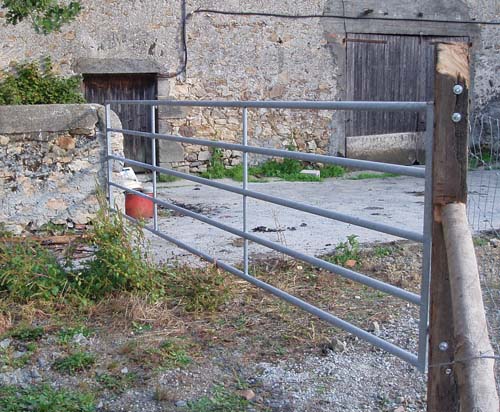
We needed a gate of four to five metres apparently. Eh, was that four metres or five Gerard? No, four to five metres. Agricultural gates are tubular steel affairs and the last metre or so is of smaller diameter, so that it can slide backwards and forwards inside the rest of the gate. Hence the gate can vary in width by a metre or so. When a farmer decides to put a gate in a fence, he doesn't get out his laser measure, he just paces out the rough size he wants and then buys a gate that can be a bit bigger or smaller. Simple, n'est pas. At the local agricultural supplies store, we bought a four to five metre cow-proof gate for the same price as I had been looking at for a one metre garden gate for our English garden. Not quite so pretty perhaps, but it will last for ever and never need painting.
So, mark up another milestone in our march to civilisation, we now have a garden gate. Not really a gate between our garden and the outside world, but at least a gate that everyone in the hamlet can swing on at the same time.

We also have a sheep and chicken proof garden fence, that can be made cow proof by running barbed wire along the top. You can't see the wire grill attached to the posts as it is very fine, but much tougher than your average chicken wire. The strands are closer together at the bottom, where short legged chickens roam, than at the top, where the sheep will nudge against it.
You will notice how our new fence clearly delineates the scruffy farmyard next door from our beautifully manicured garden. O.K. maybe not quite yet, but it will be beautifully manicured one day.
An interesting fact about fences in France is that you are not allowed to plant anything closer than half a metre to a fence, even if it is your fence. Another idea which came out of the heady days of the first republic; after the revolution, but before the heady days became headless days. Every French person's home is his chateau. No one and nothing may cross the boundary fence without permission and that includes plants. The only time when it is acceptable to break this law is when your fence butts up to public land. Stealing a little bit from the state is O.K.
Heating dragged kicking & screaming into the 21st Century
One of the estate agent's selling points for Montgomard was that it had central heating. I took one look at it and decided that it didn't. There were copper and steel water pipes draped across every wall and a large old oil boiler that, when I took it apart, was so coked up that very little hot air would have ever got to the water pipes. It was a system that was obviously very good when it was first installed, but by the time we arrived, would have changed frosted rooms to just very cold rooms, which for hardy farming types probably felt balmy, but central heating for soft English types, no.
That means more channelling. I don't know why we don't like heating pipes exposed, as it can give a sort of industrial design feel to a room, but it's not us. So trenches in the floor , some 200mm deep are needed from the point where the boiler will be installed to every radiator. The floors are all 50mm thick concrete, on top of crushed rubble, some 100mm thick, on top of the earth. No problem for my electric kango hammer, except in the living room, which has tiles laid over the concrete. The hammer just skids across the tile, dragging me with it, until it decides to bite in wherever it feels like; so it is necessary to cut though the tiles with an angle grinder first.
The choice you now have is whether to cut wet or dry. Cut wet and there is a whole load of mud to clear up, cut dry and dust gets everywhere. Cami decided that dry dust would be easier to get rid of, particularly as she is trying to reduce the relative humidity before we leave for the winter. So; new filters in the particulate dust mask and away we go. What I have learned is to only cut through the tiles, as the breaker will handle the concrete underneath; as soon as red dust turns to white, stop pushing down. After a while, it becomes routine and you can gallop across a room, scoring parallel lines which mark the edge of the trench.
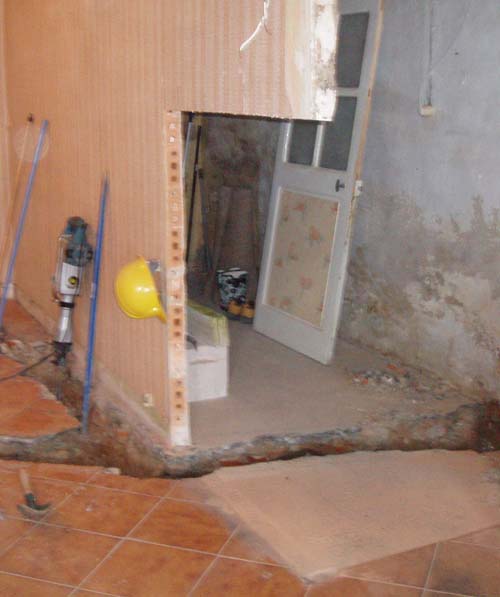
You can see in this picture the main trench coming out of the cellar wall on the right, crossing under where the staircase is going and then splitting out to feed the various other rooms on the ground floor.
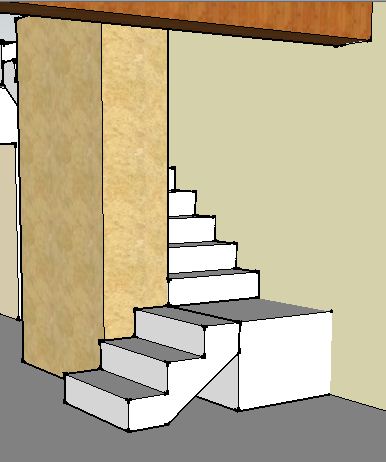
I was particularly pleased at the straight cut I was able to achieve in the terracotta bricks of the passage wall using an electric construction saw. I was worried when I bought the saw that I might not have many uses for it, but so far it has been one the hardest working tools in the box. You can change blades very easily and there are blades for wood, metal and brick. I have only cut enough away to allow work on the trench, but the cut will be continued up to the ceiling. Another cut will be made further along and then the remaining bit of wall will be blocked out with some cellular concrete blocks, so that it looks something like the picture on the right.
Not sure about the exact design of the staircase yet, but the big brown thing at the top of the picture is the main beam of the ground floor, so I have to make sure that peoples heads don't come near to it when they are climbing the stairs.
The heating network design offered by our central heating engineers, LeCompte and Sons, has altered, and now looks much more like the design a competitor offered. Given that the difference in price was really about the boiler, then I am not concerned; just intrigued as to whether Mr LeCompte has been brought into line by his more modern trained sons. Anyway, we now have one of these French collector points, which I had been trying to avoid, but at least it is in the back kitchen rather than the living room and the advantage is that, as one of the son's has designed it, each radiator can be demounted for decoration behind it without affecting the rest of the system. Assuming that, like me, you have a one ton engine crane available to lift it off the wall hooks.
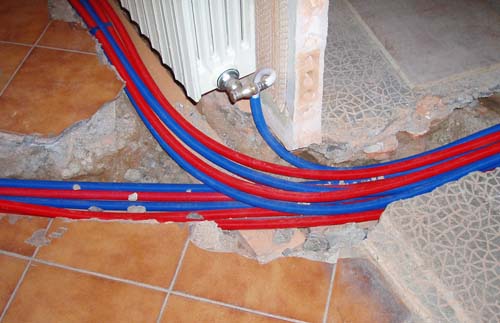
Much more piping with this design, which at least will fill all the trenches I have dug, but no underground joints. In fact no joints anywhere apart from at the collector and at each radiator, as the piping is all flexible multi-couche. The red and blue don't really denote hot and cold by the way, just out and return.
I have been keen on multi-couche piping since I first read about it. As the name implies, it is constructed of multiple layers and these are various types of plastic and aluminium. It is flexible, but not floppy, about half way between copper and plastic in bendability. Large diameter bends can be made by hand, but for the small bends needed to connect radiators, you need special tools and it will stay in the shape that you bend it, so get it right. Apart from being somewhat flexible, there are two other advantages: Firstly. it doesn't lose heat as badly as copper, although we will be wrapping it in insulation before covering it with concrete, and secondly, our very soft and therefore acidic water tends to eat through copper. Multi-couche used to be more expensive than copper, until the price of metals went through the roof, so now it is not only a technically superior option, but a cheaper one.
It's a couple of days since they started and they have hung some of the radiators and just placed the boiler on its plinth. We are beginning to worry. In England, our heating system consists of a small gas fired condensing boiler that hangs on a wall in a bathroom cupboard and a number of steel, double row radiators, none more than three feet long.
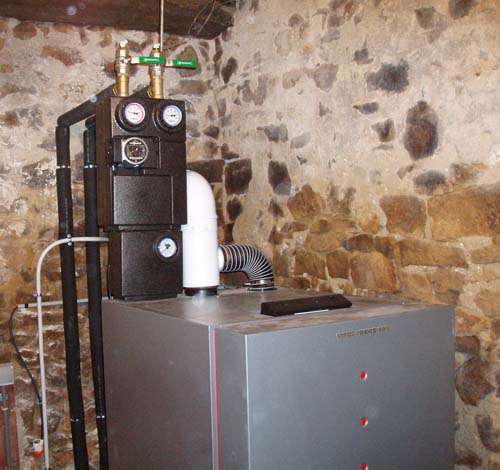
Here we have an oil fired condensing boiler that sits on reinforced concrete, with control valves that would not look out of place on the QE2. We have christened it the Titanic and are beginning to wonder whether we aught to have told the engineers that we don't like being too hot. It is connected to the huge cast iron radiators that were already in the house. Two of them in the living room glare at each other and we have decided that if anyone walks between them, they will be instantly vaporised. It is also clear that the winter will be spent with every window wide open and regular rolls in the snow to cool down. Our own personal contribution to global warming looks like it's going hyperbolic.
You can just see a couple of tapped off pipes coming out of the top of the infernal contraption. These will provide the feed to the upstairs when we get around to developing the loft.
Our other big problem is that we have been strictly instructed to only use the finest oil in our state of the art German boiler. This is a shame, because we had just done a deal with Jean Marie to add our heating oil order to his tractor fuel order, because it is much cheaper to buy oil for a farm than oil for a house. Wink, wink, nod, nod. We are now going to have to tell him that his French tractor fuel is too crappy for our superior German boiler. I think this is the point where "we are all Europeans now" will break down.
The Great Electric Saga
It is with heavy heart I tell the tale of how the hall of the Pomeroys was brought into lamentation and despair by that monster of electric power, EDF.
To be fair, it wasn't just EDF to blame, Charles, our electrician must bear some of the responsibility and I must also shoulder some blame for not listening to my sceptical self.
In my last letter, I said how we were so close to successfully completing the rewire part of the renovation and that we just had to get EDF to move the point where electricity entered the house. When we left for England, we had not received a quote for the work at our French address and there was nothing waiting for us in England. Alarm bells starting ringing in the sceptical side of my brain but, for some reason, I ignored them, telling myself that between them, Charles and the supply company must have everything sorted out. How stupid can I be; I know from many years of bitter experience that if I am not sitting with my arse pressed firmly against their face, no one organises anything.
So we get back to France, get a contact number and Cami calls EDF, who arrange to visit. Not to start work you understand, but to collect the information necessary to provide a quote. Three months completely wasted and we now have just six weeks to get it all done before we leave for the winter. C'est la guerre.
Four weeks to go and we now have the quote, €870, one hundred Euros under budget, so good news there. It is Saturday, so Cami pays for it on-line and we race into the post office in Le Dorat to send back the acceptance document. We will phone them on Monday and see if we can get them to do the work before we leave. It should take all of a couple of hours for them to feed an extended cable, so I am not hopeful.
How could I have thought that the good fairies at EDF were goblins? Still three weeks to go before we leave and they are coming next Monday to connect us up. Needless to say, I am not going to be holding my breath, but by next Tuesday, if the fates that rule all good sagas are kind to us, we should be able to boil a kettle, use the microwave and turn on a light, all at the same time.
Our hearts are light and our songs are joyful as we leave the lair of the electric monster. It's Monday evening, October 10th and we have a fully functioning electrical system where we can once more use the maximum 6kw instead of the 2kw we have had available over the last few months. However, the day still contained some minor battles with the monster and Cami almost lost her temper. That rarely happens, but when it does, duck and cover.
Soon after 09:00, a van pulled up and out got tall Grumpy and short Grumpy. The expurgated version of the conversation that ensued went something like this.
Tall Grumpy: "Why are there two lengths of trunking? We are only supposed to fit one cable."
Us: "Don't worry about the second one, that is for later, when we cable up the workshop."
Tall Grumpy: "But I might have to come back."
Us: "No you won't, our electrician will handle all of that. That is the trunking for you, right here."
Tall Grumpy: "Anyway, I can't do the job. It's more than ten metres."
Us: "No, it's seven metres end to end."
I was guessing a bit here, but wasn't about to see their van disappear.
Tall Grumpy: "Call your electrician, I need him here."
they start work and there is a short pause in negotiations whilst Charles drives over from where he is working in Bellac.
Charles: "What's the problem mate?"
Charles didn't actually use the French for mate, as that would have been too impolite unless Charles had known Grumpy for at least twenty years. What he probably said was something like, "Greetings, oh exalted servant of the electric monster. I have come post-haste to aid you in your problems."
Tall Grumpy: "I don't have any problems. What are you doing here?"
Us: "Eh, you asked us to call him."
At this point Cami retired before she did physical violence to one or other of the Grumpies and they proceeded to complete the job in plenty of time for an early lunch. For some reason, they weren't offered coffee.
My theory as to why they were so grumpy is that they were on special training to prepare them for a transfer to EDF in England, With that attitude, they would fit right in.

That little box to the right of the GTL board is what all the fuss has been about. It houses the main circuit breaker and the electricity meter.
We did consider putting our maximum concurrent wattage up to nine kilowatts at the same time, but have decided to wait until next year and see how things go. After all, Charles runs his house on 6kw and uses electric heating, so maybe we can save a bit by staying on a lower tariff. I must break off now whilst I wander round turning electrical appliances on, just for the hell of it.
New tools
Today, whilst mooching through a catalogue, I came across a genuinely useful new take on an old tool. Portable circular saws have been around for over fifty years, so a new saw by Kress, a Swiss manufacturer, would usually spark no interest, but this one didn't have a circular blade, it had a chainsaw blade.

Here it is; a bog standard looking circular saw down to the base plate, with ten inches of chainsaw sticking out below that, with a riving knife behind it.
For those of you not familiar with woodworking machines, a riving knife is a thin piece of metal which follows a blade to prevent the slit that is being cut from closing behind the blade. If you saw the consequences of that happening, you would agree that a riving knife is a good idea.
Even in the U.S., where manufacturers routinely resist any safety measure which adds to cost, riving knives are now required on all new table saws. However, I need to be very clear here about what I say about safety measures. Woodworking, even without any machinery is dangerous. My father managed to rip half way through two fingers with a blunt handsaw. With machinery, woodworking is much less dangerous than driving a car, but it is still somewhat dangerous and therefore requires some care.
The good news is that the dangers are obvious and many thousands of happy hours of working with wood are accomplished the world over with nothing more painful than the odd splinter.
We should make our woodworking machinery as safe as possible, without limiting its function. A riving knife will prevent ninety percent of injuries without affecting the performance of a saw one jot. A blade guard (a piece of plastic which sits over the blade) will prevent most of the other ten percent, but only the expensive ones can be used to make cuts that do not cut through the timber completely. Which I why I take mine off when I am making such cuts.
An injury, caused through stupidity, is getting the U,S, courts to consider making it mandatory for all woodworking table saws to be equipped with flesh sensing technology which forces the blade to stop quickly when it starts slicing through fingers. Whilst the technology works, it has to trash the blade to achieve its effect and costs a fortune to install.
Kickback of a piece of wood caused by the wood closing behind a cut can happen to the best of us, so simple, cheap, unobtrusive riving knives should be part of the design. Putting your fingers anywhere near a fast moving blade is an act of consciously putting yourself in harms way, so flesh sensing technology and blade guards should be made available, but optional.
Think of it this way. We could undoubtedly design cars that would brake to a stop whenever they sensed a pedestrian within ten metres. Should that be made mandatory for all cars sold? You decide, but at least we can ban bull bars, which served no purpose other than maiming and killing pedestrians with monotonous regularity.
Where was I, oh yes the new Kress saw. So why would you want a chainsaw attached to a circular saw frame? Directional control that's why. I was thinking just the other day, when looking at my potential workshop, how I was going to cut mortises and tenons in roof timbers which are eight inches thick without doing it by hand. I could use a chainsaw, but it is difficult to keep a chainsaw going in the perfectly straight line that I need for a tight fitting joint. The Kress saw gives me a ten inch depth of cut with complete directional control, bingo.
It wouldn't sell in England, but here and in the U.S., where timber framed houses are big business, it looks like a winner. Now, all I have to do is to sneak it into the budget somehow.
Off to the show
It's Saturday, October 15th and another glorious day of clear blue sky and bright sunshine, though there was a frost early this morning, the first of the year.
Gerard's son Eric showed some calves in the local livestock show and so we went into Magnac Laval to have a look round. It is a small, local affair with about fifty animals, a refreshment tent, half a dozen shiny new tractors and a couple of stalls selling meat, cheese and honey.
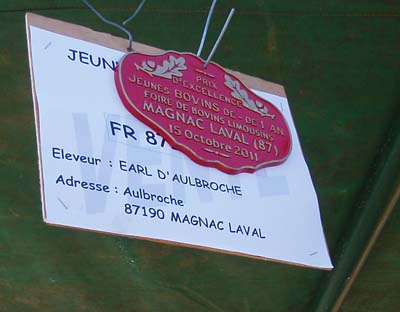

One of Eric's calves won first prize in it's category. Above is the prize plaque and, on the right, the handsome buck that won it. Less than a year old and already as big as a horse. He can afford to look smug.
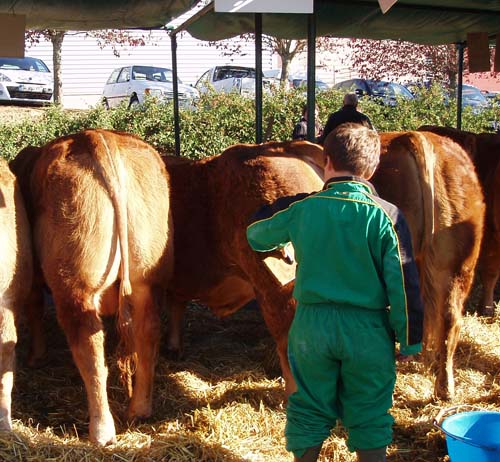
Around here, you are never too young to learn how to wash the muck off a cows bum before the judges appear.
We also learned that, for cattle, dogs and horses at least, if you know an animal's name, then you know how old it is. The first letter of the name denotes the year of birth.
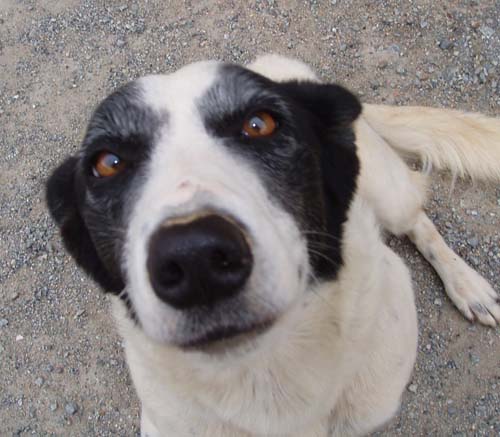
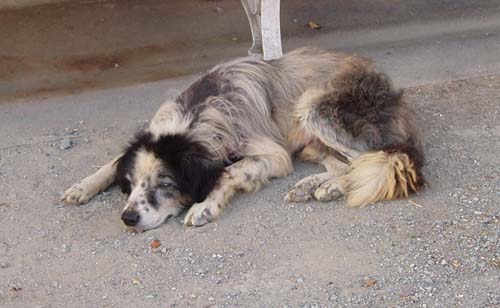
No one could tell us when it all started, but 2011 is an F year, so Dolly, the mad farm dog on the left, is two years old and the flea-bitten, mangy mutt Pollux is either fifteen or seventeen, depending on what they do with the X and Z years; which explains a lot, although he still manages to chase down his share of field mice. Here he is, alert and attentive as ever.

Just to complete the rogues gallery, here is Oscar, lying down in the road to block the traffic. There is some debate over whether this is a protest, or terminal laziness. According to the naming convention, Oscar must be a year older than Pollux, but Yvette thinks there may have been some confusion as to what year it was.
Cami also pointed out that, with this system, you could never have a Castor to go with the Pollux. I have no idea how widespread the naming system is, but if you come to this part of the Limousin, at least you will know how old the cow is that you are buying. Unless of course they change the name, like winding back the mileage counter on a car, or get confused as to which year they are in.
The long hot summer (and autumn) of my content
It is 14:00 on the fourth day of October and the temperature is heading past 30° yet again. It's too hot for the dogs to bark, or the cows to moo and even the lizards are slow to get out of your way. I can't go outside without a hat on and working in the garden really tires us out in the way that only heat can.
The current heat wave is not only washing over the Limousin, but is lapping right across western Europe. Record October temperatures were recorded in England the other day.
Everyone says that it is abnormal for it to be so hot this late in the year, but what is abnormal, now that we have invented global warming? For me, it can stay abnormal until it becomes normal. The sunflowers have given good head, the corn is up to the top of the elephant's tibia and the cows are looking fat and happy. Not the bulls; but then they never look happy. There is always a "You clocking me pal?" look about them.
I keep mentioning corn, of which a lot is grown around here, so perhaps I ought to explain why. This is cattle country: We rear beef and veal, hunt wild boar and fish for pike and trout, O.K. So why do we grow corn and sunflowers? Well, the sunflowers go for cooking oil and the corn is turned into silage.
In England, corn is called maize whilst it is growing and corn on the cob whilst it is being eaten. Here, it is maize from start to finish. Another example of the linguistic differences between Norman masters and English peasants?. Not really, as maize is a French word and you would expect an English word for the growing bit in England.
In the Limousin, we would not be seen dead chewing on a corn cob smothered in butter and trapped between those little corn forks. Instead, the whole plant is harvested and ground into silage for winter cattle feed. So the Norman lord may never have eaten maize, just fed it to cattle and English peasants, just like English landowners use oats Doctor Johnson describes oats in his dictionary as "A cereal that is fed to animals in England and people in Scotland. So corn would be "a cereal that is fed to cattle in France and people in England."
The calving shed opposite is busy again and the first cute brown calves can be seen poking their heads out into the sunlight. One of them got under the shed gate somehow and apparently joined Camilla in our garden. Pity it wasn't a bit bigger so that it could have eaten some of the weeds, but it could hardly walk, let alone eat solids. It was safely herded back by our neighbour Guy, after Cami corralled it. Another string to the woman's bow, Camilla the cowgirl.

Our collared doves which, as you all will know are bigger and greyer than turtle doves, are making a new nest in the oak tree outside the bedroom window. I learned from Cami that they nest all year round, even in the winter. Each time producing two white eggs. As I am morphing into a peasant, I am beginning to wonder how many pairs of doves I need to attract to make a decent omelette, or at least a pigeon pie.
Many years ago, I read a science fiction book where the world ended because it moved too close to the sun. Apparently the story was based on an experience of one summer spent in France when it was so hot that that some old people really thought it was happening. Perhaps it is happening again?
All in all, for me the idyll has appeared. It may be full of flies, for which I am designing fly screens, dog shit, for which I have invented the kick up the arse and the smell of cattle - no ideas for this yet, but I have approached FranceGaz to see if they have any way of bottling it; but with this weather, these skies; sparkling blue during the day and sparkling with stars at night, some kind neighbours and special offers on Bordeaux wines at the local supermarket, this is me living life to the full. I don't miss the internet, or television and as I can download books to my Kindle just as easily from here as from anywhere, I don't miss my second favourite pastime after knocking old houses about. But ask me again when it is freezing cold and pouring with rain next week.
The heat wave finally broke on the fifth of October and more autumnal weather has settled in. Still very warm in the middle of the day, but now cooler in the mornings and evenings. The light is leaving the sky earlier and I am still getting used to how much quicker night falls here than in England. Nowhere near as quickly as in the Tropics of course, but much more quickly than in the lazy evenings of England, where the light seems reluctant to leave. In England the day doesn't so much end as fade away.
I am hoping that we can stay until our planned departure date of 28th October, but without heating, we may have to retreat early if a cold spell sets in. Why do we talk of a "spell" of weather? Is it because we used to think that weather was controlled by gods and spirits. In these enlightened times of course, we know that it is controlled by the BBC weather service and so should probably call it a "programme" of weather.
We finally came back on 26th October, simply because I had a feeling of foreboding that the great weather would break all of a sudden and we would be frozen in place. The weather didn't break of course and it has remained warm in both France and England.
Last updated 01 November 2011